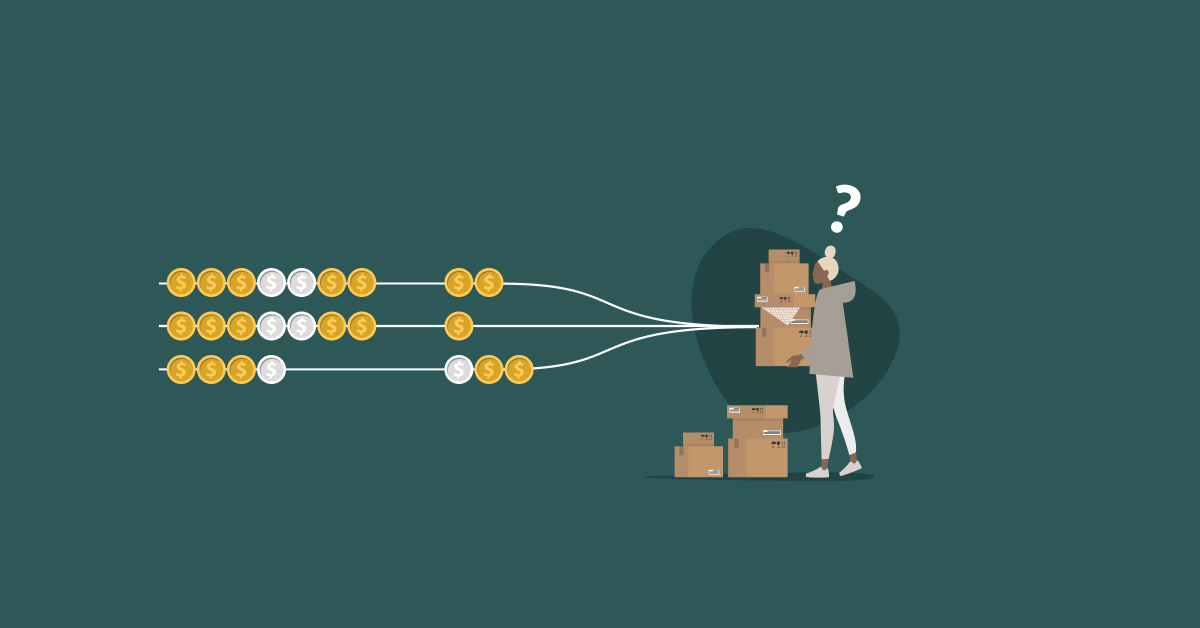
Getting up to speed with key retail costs can be the difference between growing and grinding to a halt. Enter your Cost of Goods Sold.
For anyone planning to start a new retail business, this article will give you a primer on Cost of Goods Sold (COGS). With the help of industry experts, we’ll answer retailers’ common questions about this useful accounting measure. We will cover:
- What COGS means in retail
- What’s included in COGS
- Why COGS and gross profit are (very) different
- How COGS and operating expenses differ
- How you can calculate your COGS
- What new retailers often get wrong about COGS
- How you can manage your COGS
- Brick-and-mortar vs ecommerce COGS
- What’s happening industry-wide with COGS
Searching for the right POS system?
Our free guide will help you understand the kind of point-of-sale system you need to run your business efficiently.
What does Cost of Goods Sold (COGS) mean in retail?
What are COGS?
For any absolute beginners reading this, let’s start with a brief definition.
COGS or cost of goods sold refers to any cost that goes directly into products sold by a manufacturer or retailer.
“COGS are typically those expenses that are directly attributable to the acquisition of inventory and bringing it to the location of sale. That usually includes the cost of the inventory, freight, duties, shipping, and packaging,” said Abir Syed of UpCounting.
Why is understanding COGS crucial for retail success?
Understanding COGS (Cost of Goods Sold) is essential for retail success because it directly impacts your profitability. Your COGS represents the cost of producing or acquiring the products you sell. Knowing this number helps you determine how much you’re truly making from each sale. If your COGS is too high, it can squeeze your margins and eat into your profits—even if your sales are strong.
With a clear understanding of your COGS, you can make more effective pricing strategies that balance profitability and competitiveness. It can also help you manage inventory better, ensuring you’re not overstocking and tying up capital in slow-moving items. All in all, understanding COGS empowers you to make better decisions, manage your cash flow and improve your profit margins.
Good to know
|
What’s included in a typical retailer’s COGS?
Your retail business might be a lot different than others, but these are some of the most common costs included in retail COGS.
- The wholesale cost of products
- Raw materials for manufacturing
- Costs for parts to make a product
- Factory labor costs
- Shipping and freight costs
- Storage and container costs
- Manufacturing site overheads
Common challenges in calculating COGS for retail
Calculating the cost of goods sold retail can be trickier than it seems, especially when it comes to inventory tracking and valuation. These are some of the most common challenges retailers face when calculating COGS:
1. Inventory value
One common challenge is figuring out the value of your inventory. There are two methods, FIFO (First In, First Out) or LIFO (Last In, First Out). The method you choose affects how you calculate the cost of the goods you’ve sold. With FIFO, you assume the first items you buy are the first ones you sell, which works well if your inventory is perishable. But with LIFO, the most recent inventory is sold first, which can be beneficial in times of rising prices.
2. Inventory tracking
Inventory tracking can also be challenging, especially when you have a lot of products or your stock changes quickly. Without an accurate system, it’s easy to lose track of how much you have or overestimate the value of your goods, which can lead to mistakes in your COGS calculation.
3. Inventory shrinkage
Retailers often face some kind of inventory shrinkage, which refers to the loss of goods due to theft, damage or miscounting. These losses can affect the accuracy of your COGS calculation. If you don’t account for shrinkage, you might end up overestimating your inventory value, leading to inaccurate COGS. Regular stock audits and adequate inventory management systems can help mitigate this issue.
COGS vs gross profit: what’s the difference?
“By understanding COGS and gross profit, a retail business owner can better gauge how to price the merchandise they sell,” said Jessica Distel, director of business services at Buckingham Advisors. If you’re brand new to these concepts, here’s how to tell the difference.
Understanding COGS
As we explained earlier, COGS is a variable cost showing how much you spent on the merchandise before selling it to your customers.
Understanding gross profit
Gross profit is your revenue—the income you are left with after deducting your total COGS and operating expenses, and before you even begin to consider tax.
- The difference between the retail price customers pay for your products, and your COGS is your profit margin.
- Similarly, the difference between the retail price you receive for a specific product and the COGS is your product margin.
Understanding profit margin
COGS can have a huge impact on a retailer’s profit margins because it is usually the biggest overall expense category for most brands, according to Ryan Turner, founder of Ecommerce Intelligence, an email marketing agency. “Optimizing COGS and looking for ways to reduce spending—without impacting product quality—can have a large positive impact on your bottom line,” he said.
COGS vs operating expenses
One thing to keep top of your mind is that COGS are tied to sourcing or making your products and bringing them to where you will sell them. They are not part of your operating expenses.
“For retailers, COGS or inventory is typically the largest ongoing expense in the business,” said Lee Whitaker, a senior manager at retail and wholesale consultancy, the Parker Avery Group. “All other expenses will fall into operating expenses or capital expenditures.”
Operating expenses are a much larger bucket, said Hillary Senko Cullum, a wholesale and retail consultant operating at HSC Advisors.
“Operating expenses encompass much more than just the cost of inventory. [Operating expenses cover] everything required to run the business from paying rent, to utilities, to payroll. The COGS is a type of expense that is tied directly to the product being sold, while other expenses are the cost of running and operating the business.
How do you calculate COGS?
COGS is affected by a wide range of factors. And that’s why it can be hard to calculate and forecast correctly, said Ecommerce Intelligence’s Turner. “The cost of raw materials and manufacturing, employees involved in fulfillment, shipping, and freight prices all impact COGS. Price fluctuations in any of these categories will often impact COGS,” he said.
COGS formula
You can use a formula to work out your COGS.
To use the formula, you will need:
- The value of your starting inventory. This is the dollar value of items you have in stock and ready to use or sell at the start of an accounting period, like a month, or quarter.
- The value of your purchases. This is the dollar value you spent on the COGS examples we gave earlier, such as raw materials.
- The value of your ending inventory. This is the dollar value of your remaining inventory at the end of the accounting period mentioned above. You can do an inventory count to arrive at this value.
Once you’ve confirmed these figures, here’s the formula you use.
(Starting Inventory + Purchases) – Ending Inventory = Cost of Goods Sold
Tax implications of COGS for retailers
Properly tracking COGS is crucial come tax time. The cost of goods sold can be deducted from your total income, which helps reduce your taxable income and lowers your tax bill. But to take advantage of this deduction, you have to keep accurate, up to date records.
Without proper reporting, you may under or overestimate your COGS, causing potential issues in an audit. If you overstate your COGS, you might underreport your income, which can lead to penalties. On the other hand, underreporting COGS could mean you’re paying more taxes than you need to.
Regularly updating your inventory records and using the right accounting methods are essential for ensuring your COGS is calculated correctly for tax purposes. Understanding COGS in retail and how it relates to your business helps ensure you can maximize your deductions and avoid discrepancies.
What do new retailers often get wrong about COGS?
One of the most common mistakes made when calculating COGS is either overstating or understating inventory levels and not reflecting the correct amount of inventory a retailer has paid for or is keeping as inventory. “This is very easy to do,” said Turner, “but it makes a big difference to a brand’s accounting because it may significantly affect the overall profit and loss by either inflating profits or making them look lower than they actually are.”
How can you manage COGS?
One way to keep COGS within reason is to look backwards and forwards through your accounts regularly. Syed suggests retailers get bookkeeping done regularly to monitor how expenses are trending relative to how much they’re making.
“That way if things aren’t going in a favorable direction you can quickly react to it,” he said. “The key to doing this well is checking your actuals versus forecasted each month to identify how well you forecasted—and to improve future forecasts. When you get better at forecasting you can make more confident decisions,” he said.
Brick-and-mortar vs ecommerce: how can COGS differ?
Brands with brick-and-mortar stores will usually have additional expenses which will need to be included in their total COGS. These will usually be related to labor and operational costs necessary to get products into the hands of customers, said Turner.
“Examples could be additional staff employed at a retail location, rent paid for brick-and-mortar stores, along with other expenses such as utilities. Brands that sell solely via ecommerce have fewer expenses in these categories in most cases, as they do not have costs related to running and maintaining physical locations.”
What’s happening with COGS across the retail industry?
Senko Cullum said she is seeing examples of COGS increasing by as much as 10%, driven by global inflation and supply chain limitations. “Inflation costs have increased the cost of raw materials, manufacturing, shipping and transport, all of which flow into the cost of creating a product.”
Frequently asked questions
What type of companies are excluded from a COGS reduction?
Certain service-based companies, like law firms, consultants and digital service providers, are excluded from a COGS reduction because they don’t sell physical products or have cogs retail expenses.
What is included in the cost of goods sold?
COGS includes the direct costs tied to producing or purchasing goods, such as raw materials, labor and manufacturing costs. It also includes shipping or handling costs for getting products to your business. The average COGS for retail can vary but typically involves these direct costs.
Are salaries included in COGS?
Salaries are only included in COGS if they’re directly related to the production or sale of goods.
How does inventory affect COGS?
Inventory directly affects COGS because the value of the inventory at the beginning and end of a period helps determine how much you spent on goods sold during that time. If your inventory is inaccurate or not tracked properly, it can lead to mistakes in calculating your COGS, which can affect your profit and taxes.

News you care about. Tips you can use.
Everything your business needs to grow, delivered straight to your inbox.





